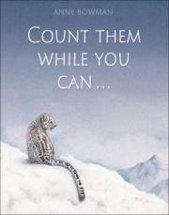Count them while you can by Anne Bowman

Little Hare, 2010. ISBN 9781921541605.
Highly recommended. Count them while you can is a superb
introduction
to endangered species
for young children and it is easy to see why it was listed as a Notable
Book for The Eve Pownall Award for Information Books for 2011.
It focuses on the mothers and babies of ten of the world's most
endangered creatures including the Californian sea otter, the
red-ruffed lemur, the kakapo and the numbat. Each creature has a
double-page spread that introduces the creature and their habitat in a
gentle counting rhyme (sung to the tune of Over in the Meadow)
and a
text box of simple but vital information that includes the threat and
current numbers, both against a backdrop of a soft, engaging
illustration of the species. Notes at the back explain how we
know if a creature is endangered and the various levels of threat that
they are under.
When our students think of extinct animals, they think of dinosaurs,
woolly mammoths and sabre-toothed tigers, but the reality is that there
are over 50 species of Australian animals and over 60 species of
Australian plants that are extinct and about 240 species of native
animals and over 1160 species of native plants may become extinct in
the near future. (Green Kids Guide to Threatened Species). Those
figures are just for Australian species - the IUCN Red List has more
alarming figures for the world generally.
With students becoming more environmentally aware all the time,
introducing them to the concept of endangered species would seem to be
a natural part of the curriculum. So often we are hampered in finding
information at the level the younger child can manage but Count them
while you can fulfils this need very well. It develops an awareness
that 'extinct' and 'endangered' are very much concepts of our time and
the fate of the dinosaurs et al awaits creatures that we know today.
Because information literacy involves creating information as well as
just using it, using the book, its information and format as a
springboard for research and a model for a simple presentation of facts
makes sound educational sense.
Barbara Braxton